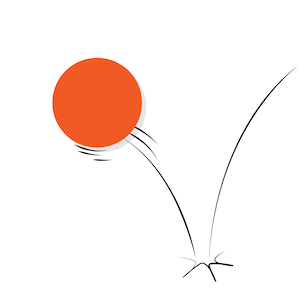
Prep. Lesson 10. Louder & softer voices
-
-
- Battery-powered candle Difficulty:
 Prior learning: None
Prior learning: None
- Battery-powered candle Difficulty:
-
- Woodblock or similar, bouncy ball
 Practising beat continues in these following lessons. However, we introduce louder and softer voices, which are essential in teaching young students about vocal dynamics and volume control, marking the beginning of understanding musical comparatives. Introducing louder and softer voices helps students learn to adjust their speaking or singing based on different situations, developing self-awareness and communication skills. Activities that explore the comparatives engage students in recognising contrasts and controlling their vocal output. Using props adds a fun, interactive element. This approach introduces musical concepts and encourages students to use appropriate voice levels in daily life.
Practising beat continues in these following lessons. However, we introduce louder and softer voices, which are essential in teaching young students about vocal dynamics and volume control, marking the beginning of understanding musical comparatives. Introducing louder and softer voices helps students learn to adjust their speaking or singing based on different situations, developing self-awareness and communication skills. Activities that explore the comparatives engage students in recognising contrasts and controlling their vocal output. Using props adds a fun, interactive element. This approach introduces musical concepts and encourages students to use appropriate voice levels in daily life.
![]() Students practise singing with different vocal dynamics, switching between daytime (loud) and nighttime (soft) voices.
Students practise singing with different vocal dynamics, switching between daytime (loud) and nighttime (soft) voices.
![]() Lyrics
Lyrics
I'm a bear, and I like honey,
Lots of honey in my tummy,
I'll feel sick, and I'll feel funny,
If I go on eating honey!
 Success Criteria
Success Criteria
- I can sing using both daytime and nighttime voices as instructed.
- I can match my voice to the energy of the lyrics and movements.
- Based on the teacher's or puppet's cues, I can alternate between daytime and nighttime voices.
- I can identify the differences between the two types of voices and explain when to use each one.
- Introduce the terms "loud" and "soft" to students. Explain that when we sing with our daytime voice, we use a loud voice, and when we sing with our nighttime voice, we use a soft voice.
- Use a bear puppet to introduce two types of voices: daytime (loud and energetic) and nighttime (soft and quiet).
- Explain that the bear will sing the song using both voices, and the students will follow along, adjusting their voices to match.
- Sing the song loudly and energetically in the bear's daytime voice.
- Have the students repeat the song and sing in their daytime voices, emphasising a strong, clear tone.
- Now, explain that the bear also has a nighttime voice that is soft and quiet, like when it’s time to calm down before bed.
- Sing the song again, but this time in a whispering nighttime voice.
- Have the students echo the song using their nighttime voices.
- Add simple actions to the lyrics to make the activity more engaging:
- "I'm a bear, and I like honey." Pretend to scoop honey into your mouth.
- "Lots of honey in my tummy": Rub your tummy in a circular motion.
- "I'll feel sick, and I'll feel funny" Make a "sick" face and wobble side to side.
- "If I go on eating honey!" Pretend to take one last big bite.
- Ask the students if they noticed the differences between the daytime voice (louder, energetic) and the nighttime voice (soft, calm).
- Talk about when each voice might be appropriate (e.g., daytime voice for playtime, nighttime voice for quiet time.)
![]() Students will learn to differentiate between loud and soft singing by practicing vocal dynamics while following visual cues.
Students will learn to differentiate between loud and soft singing by practicing vocal dynamics while following visual cues.
![]() Lyrics
Lyrics
Pumpkin, pumpkin, round and fat.
Turn into a jack o' lantern, just like that!
- Sing the song line by line, and have the students repeat each line after you to help them learn the melody and lyrics.
- Sing the song softly, using a quiet voice while keeping your hands close together. This will show the students that the song is being sung softly, and the small hand movements represent the quieter dynamic.
- Ask the students to join in, singing softly and keeping their hands close together like you.
- Now, sing the song again, but this time with a loud voice and your hands spread further apart.
- Encourage the students to join in and sing the song loudly, noticing the bigger hand movements.
- Ask the students, "Can anyone tell me the difference when I put my hands like this (close together) or when I put my hands like this (further apart)? Was the music different?"
- Listen to their responses. Some students might describe the sound as "big" or "small."
- Explain that when the sound is big, we call it "loud," and when the sound is small, we call it "soft."
- Repeat the activity, first singing softly with hands close together and then singing loudly with hands further apart, reinforcing the concept of loud and soft.
- Invite a student to come to the front and be the conductor. Explain that the conductor will use only hand actions to show if the class should sing loudly or softly. The conductor will raise their hands apart for loud singing and bring them closer together for soft singing.
- Rotate through different students, allowing them to take turns as the conductor. Give each conductor enough time to practice signaling for both the loud and soft versions of the song.
- As the activity progresses, observe the students' improvement in musical accuracy and their ability to follow the conductor's cues.
- Encourage students to listen carefully to the differences between loud and soft singing and adjust their voices accordingly.
 Success Criteria
Success Criteria
- I can sing using both loud and soft voices.
- I can follow the conductor's hand movements to know when to sing loudly or softly.
- Using the terms correctly, I can explain the difference between loud and soft singing.
- I can improve my singing accuracy by adjusting my voice based on the conductor's cues.
![]() Students will learn to recite the rhyme while practising louder and softer voices, and coordinating movements to match vocal dynamics.
Students will learn to recite the rhyme while practising louder and softer voices, and coordinating movements to match vocal dynamics.
![]() Lyrics
Lyrics
Two little Mickie birds sitting on a wall [hands together, thumbs up]
One named Peter, one named Paul [wiggle each thumb in turn]
Fly away, Peter, fly away, Paul [each thumb in turn moves behind your back]
Come back, Peter, come back, Paul [bring each thumb back in turn]
 Success Criteria
Success Criteria
- I can say the rhyme using both loud and soft voices.
- I can match my voice level to the actions, switching between louder and softer as needed.
- I can follow along and change my voice in time with the rhyme.
- I can take turns leading the rhyme and directing the class to use different voice levels.
- Begin by reciting the rhyme slowly and softly while performing the actions in time with the words.
- Now repeat the rhyme, but this time using a louder voice as if the birds call each other from far away.
- Ask the students to join in with both the voice levels and the thumb movements, following your lead as you change from louder to softer voices.
- Repeat the activity several times, letting them get used to switching their voices while performing the actions.
- Select students to come to the front and lead the rhyme while choosing whether to speak in a louder or softer voice.
- After practising, discuss with the students how loud and soft voices are different and when each might be used (e.g., soft voices for quiet times and loud voices for outdoor play).
![]() Students will learn to sing using both louder and softer voices while participating in a circle game.
Students will learn to sing using both louder and softer voices while participating in a circle game.
 Success Criteria
Success Criteria
- I can sing the song using both loud and soft voices.
- I can adjust my movements to match the volume level of the song.
- I can take turns leading the class and decide when to sing loudly or softly.

- Gather the students in a circle.
Explain that they will use loud and soft voices during the song. But they must be beautiful voices! - Hold hands and walk in a circle.
- Start by singing the song softly. Encourage the students to sing quietly and move gently with small steps as they walk in the circle.
- Have the students crouch quietly on the phrase "We all fall down."
- Sing the song again, this time with a loud voice. Encourage the students to walk with bigger steps and add more energy to their movements.
- On "We all fall down," ask the students to fall down with a louder clap or a bigger gesture.
- Choose a student to be the leader in the middle of the circle. The leader will decide when to sing with a loud or soft voice.
- After several rounds, discuss how loud and soft voices felt different and ask the students which parts they preferred.
![]() Students will learn to sing in both louder and softer voices while playing a ball-bouncing circle game, developing vocal control and dynamics.
Students will learn to sing in both louder and softer voices while playing a ball-bouncing circle game, developing vocal control and dynamics.

 Success Criteria
Success Criteria
- I can sing using both louder and softer voices as directed.
- I can adjust my voice according to the teacher's signal.
- I can maintain a steady beat while bouncing the ball.
- Arrange the students in a circle with a soft, bouncy ball ready.
- Take a position in the centre of the circle and let them know that they will be singing while you bounce the ball to different students.
- Let the students know that they will need to sing loudly during the activity and then switch to a softer voice when directed.
- Demonstrate the difference between a louder voice and a softer voice.
- Begin by bouncing the ball to a single student while singing. Encourage the students to sing together on the beat in a loud and beautiful voice.
- Continue bouncing the ball sequentially to each student in the circle, with everyone singing loudly.
- Keep the energy up by maintaining a strong voice and encouraging the class to stay engaged.
- Resume the game, bouncing the ball to the next student while students will sing softly in a beautiful singing voice.
![]() Students will listen to and recognise the terms loud and soft in this animated video with Zak.
Students will listen to and recognise the terms loud and soft in this animated video with Zak.
Suggested lessons
Y1. Beat II

Y1. Beat III

Y1. Beat IV

